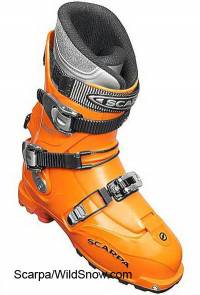
Scarpa Laser ski touring boot circa 2002. Still available on the used market and worth purchasing if you’re on a budget.
Throwback Thursday! First released around 2002, Scarpa Laser was a revolutionary ski touring boot that combined walking comfort and skiability in a lightweight package that few other boots could match. Add tech binding fittings and a last with enough toe room for nearly anyone, and what’s not to love? Well, they did ski okay but in those days we were still needing to press against the fronts of our boots, as well as have enough overall stiffness to lever skis around a turn — even if we were not dropping cliffs and enjoying other vile shenanigans.
Prior to this project I’d been modifying ski boots for years, but before the Laser I’d not come up with something this effective — this worthy of the name “frankenboot.” This wasn’t the first frankenboot by any means (ski racers had been doing such stuff for decades), but it was one of the first published ski touring frankenboots.
In the end, I’ve been told this article about Laser mods inspired countless backcountry skiers to not hesitate when it came to adding performance by modifying their footwear.
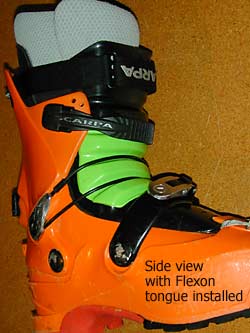
Flexon tongue shaped and installed.
Hence, I thought it fun to dig this out of our archives and give it the full glory of a blog post. Let it inspire you. A motto at WildSnow.com:EVERYTHING SHALL BE MODIFIED
Building the Scarpa Laser Frankenboot
It’s no secret that different styles of skiing require different types of boot flex. As a result, boot fitting and modification has always been a big part of alpine skiing. Ski mountaineering is no different. Some backcountry skiers like a rigid boot, some like it soft, some want it in-between. Most like a boot with “progressive” flex that gradually increases in resistance as you press your shin forward.
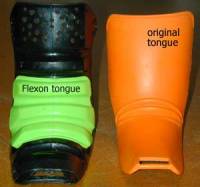
Huge difference in a 10 minute mod, replace stock tongue with stiffer.
Out of the box, the Laser is soft in forward flex, with little “progression.” No problem if you like it that way. But what if you like a bit more boot to push against, or like me, you just want the things to hold your ankles tighter, with less movement? No problem. With a bit of work, Laser will accept a stiffer tongue from many models of Raichle and Koflach boots. Here’s how:
First, find a set of tongues. Try friend’s garages first, then thrift shops and perhaps used equipment stores. If you strike out, try some ski shops. Larger and better shops sometimes stock replacement tongues for Koflach and Raichle models. Tongues come in different sizes and flexes. (Hot tip: Koflach snowboard boot tongues snap on to the Laser with little to no modification.) In my case what worked was a Flexon comp tongue from approximately the same size shell as my Lasers.
1. Remove tongues from Lasers by prying the plastic tongue retention clip up with a sturdy screwdriver and popping the tongue out. Lube with a bit of water while you do it.
2. Remove tongues from your donor boots with as little damage as possible (the Flexons required removing a rivet and leaving a hole; other boots have tongues that pop out with no damage).
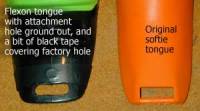
Easy to match the hole in stock tongue.
3. If necessary, use a small rotary grinder with a burr to grind out a slot in the new tongue that closely matches that in the original, leaving as much material in the forward area as possible. When you’ve got it close, try popping into the Laser, and grind a bit at a time ’till it fits.
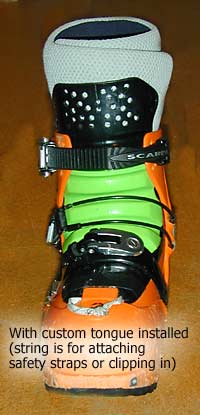
Tongue installed, shaped.
4. Latch the tongue down, observe contact points that prevent it evenly closing, and use grinder to ease those points on the tongue (do not grind the shell of the boot). The Laser has a small raised rib surrounding the lower opening, which I eased down a bit by peeling with a knife. It’s also possible to heat-mold some tongues, but only do that as a last resort, and don’t damage your Lasers while doing it.
5. To fit over the higher tongue, I needed a bit more length from my lower buckle. To get it, I drilled out the rivets holding the buckle, then re-riveted about a centimeter outboard from the old holes.
6. With everything installed, I tuned the flex by cutting a vertical slot at the top of the tongue, and drilling a bunch of holes to soften the feel (and perhaps reduce weight [grin]?). After skiing a few weeks, I realized the boots were still a bit too forward stiff, so I cut about 1/4 inch off the top of the tongue. They now climb and ski better than any of the more than 25 pairs of backcountry skiing boots I’ve owned and skied over the past decades.
More Scarpa Laser Mods!
A. I hate the way my power straps always move around, so I riveted them in place (you can see the rivet showing in the side-view photo photos of the tongue mod on the previous page.)

In these ancient of days, can you believe boots did not come with thermo liners and you had to go aftermarket?
B. After my flex was perfect, I had footbeds and custom Thermoflex liners installed. When molding the liners, I added extra material in front of my toes, so my toes wouldn’t hit while kicking steps, and they’d stay warmer. Take care when picking liners that you use ones with dense foam. AT boots are softer than alpine boots, so too soft a liner will feel like skiing with your feet in plastic bags full of Jell-O…
C. After you adjust your cuff cant (if needed) apply thread locker to the cant screw threads before final tightening.
Speaking of fit, be advised that the “anatomical” (for some people) shell of the Laser has a high arch, rather than the flat foot-ramp which most ski boots have. This arch caused me no end of angst while fitting my boots. I finally realized it was so high my foot was being suspended by the arch no matter what I did with the footbed in my liner. Once I realized the problem the solution was simple: a 3/16 inch pad glued to the top of the heel pad that comes stock in the boot shell. Everyone’s feet are different, but if the Laser feels funny to you, check the shell’s built-in arch. (Note that the professional boot fitters solution for this is to possibly “interface” the custom footbed with the shell by grinding to fit the uneven bottom of the boot shell.)
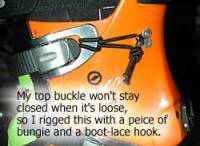
A little mod that adds a lot of comfort.
D. I like to keep my upper buckle loose for walk mode. When doing so, the buckles wouldn’t stay latched, and kept catching on things and making it difficult to work my pant cuffs up and down when changing modes.
Solution: a bit of bungie cord, a boot-lace clip, a few rivets. Tip: As my goal is to ski peaks, I always fit and modify my boots first for downhill performance, then tweak for uphill comfort. The whole process takes weeks, as I ski the boots after each mod.
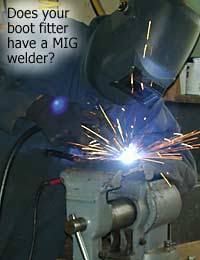
Does your boot fitter have a welder in the shop?
E. This one was fun. I hate having two settings for forward lean. I mean, who wants to be at the top of a 14,000-foot peak in the middle of winter, trying to guess which position you clicked into for your best ski performance? Not me. Being bold in mechanical things, I dismantled the Laser lean lock mechanism, welded one of the holes shut, then reassembled. Peace.
I hope you enjoyed reading about Laser boot mods, and perhaps tackling a few yourself. Let me know how it goes.
Check out the full line of Scarpa ski boots, impressive.
WildSnow.com publisher emeritus and founder Lou (Louis Dawson) has a 50+ years career in climbing, backcountry skiing and ski mountaineering. He was the first person in history to ski down all 54 Colorado 14,000-foot peaks, has authored numerous books about about backcountry skiing, and has skied from the summit of Denali in Alaska, North America’s highest mountain.
